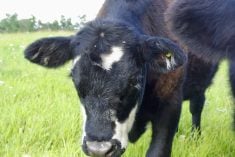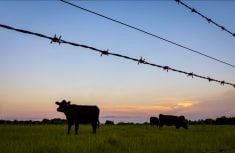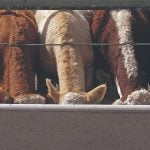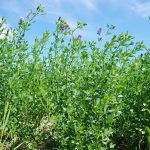Outlanders venturing west were frightened by the Great Plains, with its sweeping grasslands that extended from horizon to horizon. The only inhabitants at that time were small clusters of Indigenous people. In the beginning, great farms stippled majestic forests across Eastern Canada. Western climb gave way to deserts and mountains.
Harvey Leifert, in an article written in Earth (January 9, 2018) outlined John Wesley Powell’s initial description of what he termed the “dividing line” in his 1878 report Lands of the Arid Region to the U.S. Congress. Powell described the climatic boundary between the United States’ humid East and arid West lay along a line “about midway in the Great Plains.” Powell identified the “arid region” as the land west of the 51-centimetre-per-year rainfall line, which closely tracked the 100th meridian and its northern extension into what would become the province of Manitoba. This is about the minimum rainfall that permits farming without irrigation, and it also greatly influences the types of crops that could be grown. At the time, Powell overlooked the potential of grazing and cattle ranching. He went on to state, “Legislative action would be necessary to inaugurate enterprises by which these lands may eventually be rescued from their present worthless state.”
Along with having the 100th meridian, Manitoba also contains the longitudinal centre of Canada, notes the blog Eden in Winnipeg. The longitudinal centre sits southeast of Winnipeg, near the towns of Lorette and Landmark. Winnipeg’s location is why it grew as a large city to become the “Chicago of the North” in the early 20th century, a major transportation and shipping centre due to its access both East and West. Winnipeg also lies in the middle of North America, which is why the city’s welcome signs read Heart of the Continent, Eden writes.
Read Also

Canadian Beef Check-Off Agency reports on investments and activities
The check-off agency’s work behind the scenes is what ensures cattle check-off dollars are invested wisely, accounted for transparently and deliver measurable value back to producers and importers.
The formative years of Western Canada’s cattle industry were characterized by great difficulty. Major diseases (mange, Texas fever), catastrophic losses due to cold when chinooks failed to appear, belief native grasses would maintain herds year-round, overgrazing and unsustainable reproductive performance hindered progress for many. The challenges at times threatened the survival of ranching.
Essentially, there were only two periods before 1940 in which cattle producers enjoyed consistent profits, notes Library and Archives Canada. Profits, though meagre, existed through the years of open range, 1887 to 1900. The second period spanned 1914 to 1920 and had a significant impact on the overall development of Western Canada’s cattle industry.
Export markets were crucial to livestock industry growth, particularly after 1881 following the establishment of Alberta’s leaseholds, notes Library and Archives Canada. Between 1897 and 1911, Canada sent an average of 130,000 head annually to England where they were usually sold at prices of between $40-$50 per head at London’s Smithfield market in competition with Scottish and Irish beef.
Although the terrible winter of 1906-07 ended the early period of prosperity for cattle producers, it also saw the rise of Argentina as a beef producer and her success in producing huge volumes of cheap chilled beef indistinguishable from the freshly killed product, states Library and Archives Canada. High cost of production and freight jeopardized Canada’s share of the British market. Ranchers also realized dependence on chinooks and grass carryover to provide sufficient nutrition was foolhardy. Poor nutrition resulted in calf crops as low as 25 per cent.
Opportunity west of the 100th abounded, though success could be tenuous and had to be carefully managed. Federal policies, which favoured agriculture and the homestead system over ranching, put the ranching community into full flight early in the 20th century. The Northwest Mounted Police superintendent at Fort Macleod in 1911 referred to “ranching as being a thing of the past,” a sentiment echoed a year later by Dr. J.G. Rutherford, Canada’s Veterinary Director General, notes Library and Archives Canada. One reform included new regulations in 1913 granting closed 10-year leases, allowing for the long-range planning needed to build herds. The sudden emergence of a U.S. export market was another positive development.
Nature Conservancy magazine’s review of the book, Ranching West of the 100th Meridian, offers a thought-provoking look at ranching and its role in the changing West. “The book’s lyrical and deeply felt narratives, offer a poignant consideration of ranchers’ ecological commitments to the land. Livestock ranching in the West has been attacked from all sides — by environmentalists who see cattle as a scourge upon the land, by fiscal conservatives who consider the leasing of grazing rights to be a massive federal handout program, and by developers who covet intact ranches for subdivisions and shopping centres. The authors acknowledge that, if done wrong, ranching can hurt the land. But if done right, it has the power to restore ecological integrity to Western lands that have been too-long neglected.”
I’ll leave you with a few lines from At the Hundredth Meridian, by The Tragically Hip:
“… transport me, unceremoniously,
Away from the swollen city-breeze, garbage-bag trees
Whispers of disease and the acts of enormity
And lower me slowly and sadly and properly
Get Ry Cooder to sing my eulogy
At the hundredth meridian
Where the Great Plains begin.”

















